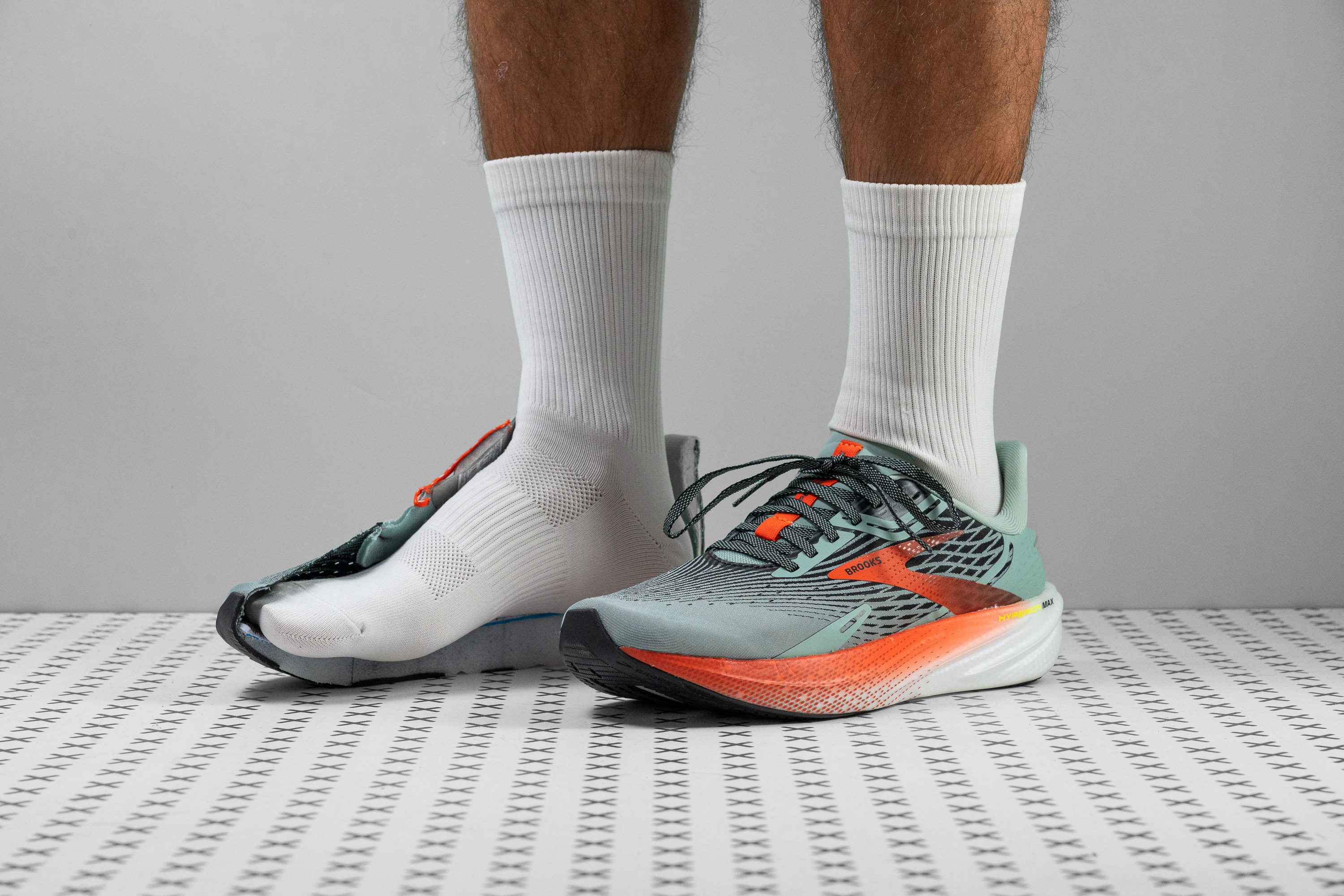Our verdict
- Top pick in best Brooks running shoes (2023)
Pros
- Seamless, comfortable upper
- Remarkably lightweight
- Secure, snug fit
- Fantastic performance in winter
- Excellent stability
- Superior breathability
- Highly durable
- Highly durable
- Highly durable
Cons
- High price tag at $170
- Not for wide feet
- Needs better energy return
- Needs better energy return
Audience verdict
- Top 18% most popular running shoes
Comparison
The most similar running shoes compared
+ + Add a shoe | |||||
|---|---|---|---|---|---|
| Audience score | 88 Great! | 90 Superb! | 79 Good! | 89 Great! | |
| Price | £170 | £110 | £170 | £150 | |
| Pace | CompetitionTempo | Daily runningTempo | Daily runningTempo | Tempo | |
| Shock absorption | High | High | High | Moderate | |
| Energy return | Low | Moderate | Moderate | Low | |
| Traction | Moderate | High | High | Moderate | |
| Arch support | Neutral | Neutral | Neutral | Neutral | |
| Weight lab Weight brand | 7.5 oz / 213g 7.8 oz / 221g | 8.6 oz / 245g 8.4 oz / 238g | 10 oz / 283g 9.9 oz / 281g | 7 oz / 198g 7 oz / 199g | |
| Lightweight | ✓ | ✓ | ✗ | ✓ | |
| Drop lab Drop brand | 8.2 mm 8.0 mm | 8.2 mm 9.0 mm | 10.6 mm 6.0 mm | 9.0 mm 8.0 mm | |
| Strike pattern | HeelMid/forefoot | HeelMid/forefoot | Heel | HeelMid/forefoot | |
| Size | True to size | Half size small | True to size | True to size | |
| Midsole softness | Balanced | Balanced | Soft | Balanced | |
| Difference in midsole softness in cold | Small | Small | Small | Small | |
| Toebox durability | Decent | Bad | Good | Good | |
| Heel padding durability | Decent | Good | Decent | Decent | |
| Outsole durability | Good | Decent | Good | Good | |
| Breathability | Breathable | Breathable | Moderate | Moderate | |
| Width / fit | Narrow | Wide | Medium | Medium | |
| Toebox width | Medium | Medium | Medium | Medium | |
| Stiffness | Moderate | Moderate | Moderate | Flexible | |
| Torsional rigidity | Flexible | Moderate | Stiff | Flexible | |
| Heel counter stiffness | Moderate | Flexible | Moderate | Moderate | |
| Rocker | ✓ | ✗ | ✓ | ✗ | |
| Heel lab Heel brand | 32.4 mm 34.0 mm | 34.9 mm 35.0 mm | 45.6 mm 46.0 mm | 28.7 mm 28.0 mm | |
| Forefoot lab Forefoot brand | 24.2 mm 26.0 mm | 26.7 mm 26.0 mm | 35.0 mm 40.0 mm | 19.7 mm 20.0 mm | |
| Widths available | Normal | NormalWide | Normal | Normal | |
| Orthotic friendly | ✓ | ✓ | ✓ | ✓ | |
| Season | SummerAll seasons | SummerAll seasons | All seasons | All seasons | |
| Removable insole | ✓ | ✓ | ✓ | ✓ | |
| Ranking | #249 Top 38% | #46 Top 13% | #321 Bottom 14% | #97 Top 26% | |
| Popularity | #119 Top 18% | #155 Top 42% | #46 Top 13% | #176 Top 47% |
Who should buy
We think that the Brooks Hyperion Max is a top choice for:
- Folks who find regular daily trainers like the Nike Pegasus 40 heavy and boring.
- Neutral runners craving a feather-light daily training shoe.
- Anyone on the hunt for a do-it-all shoe that's cool with any running pace.
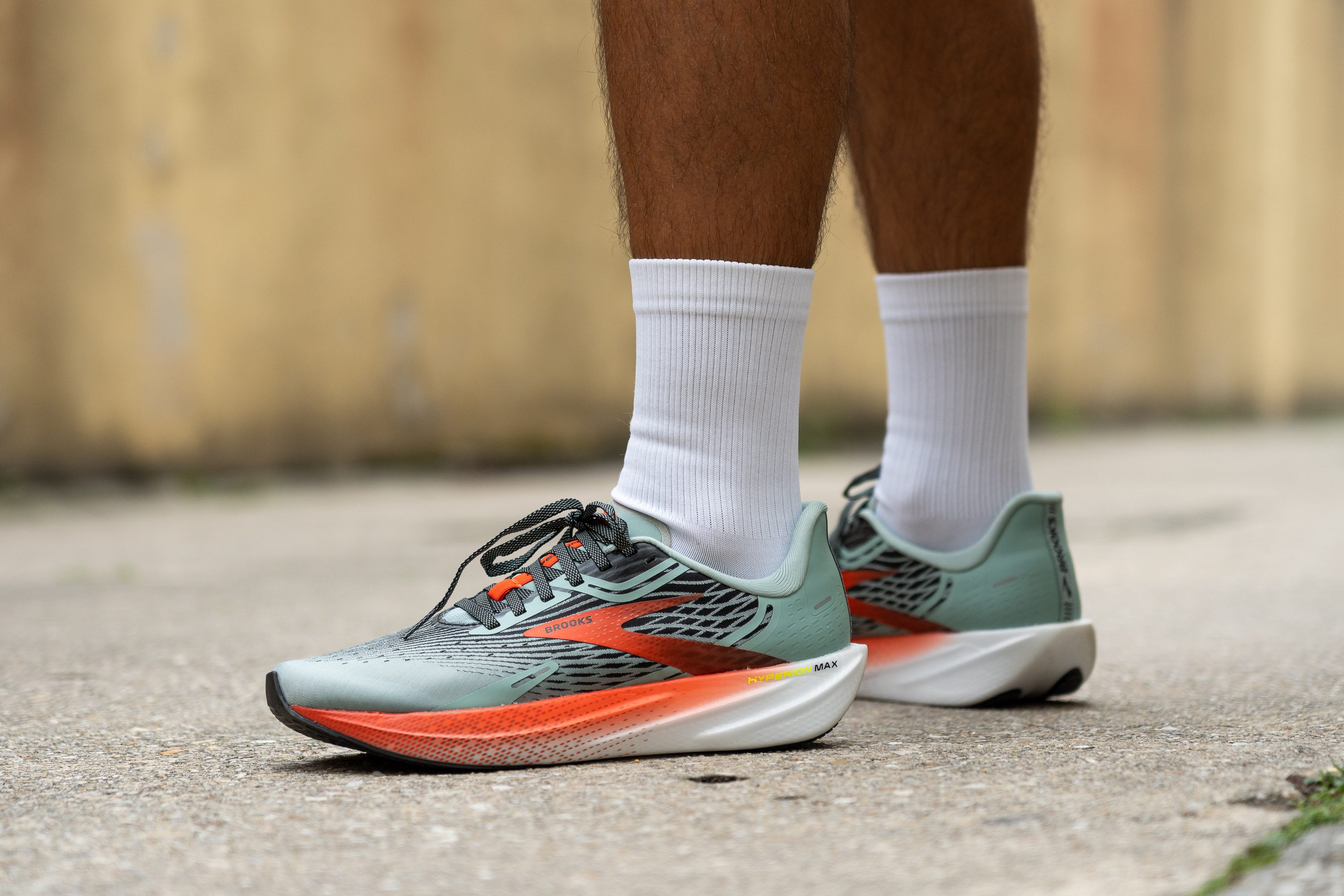
Who should NOT buy
If you have wide feet, this Brooks probably isn't for you. Based on our tests, better options with more room inside include the Nike InfinityRN 4 and the Saucony Triumph 21.
Likewise, the £170 price tag might be a stretch for your budget. In that case, you could look at more affordable options like the regular Brooks Hyperion or the popular ASICS Novablast 3.

Cushioning
Shock absorption
The “Max” label in any Brooks model signals more stack height and extra cushioning, and the Hyperion Max delivers—though not as much as some might expect.
Despite the name, this shoe isn’t particularly tall, and its cushioning lands around average with 132 SA in the heel and 104 SA in the forefoot. It feels more like a typical daily trainer than a true max-cushioned model.
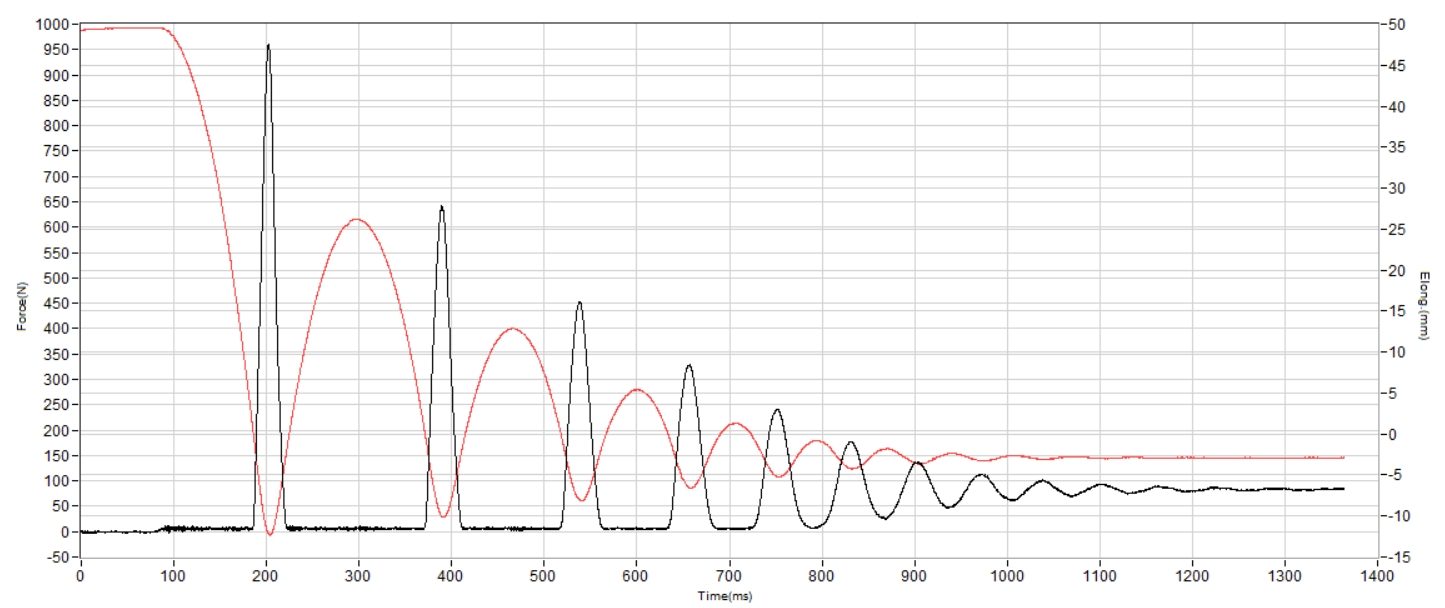
| Hyperion Max | 132 SA |
| Average | 129 SA |
Energy return
Energy return is also on the lower end, especially in the heel. It registered just 50.7% in our test—not surprising given the EVA-based foam, but there’s definitely room for improvement in version 2.
| Hyperion Max | 50.7% |
| Average | 58.5% |
Heel stack
We measured the Hyperion Max stack and found that it has a height of 32.4 mm in the heel.
This should be comfortable for most runners, including heel strikers—even for long runs.
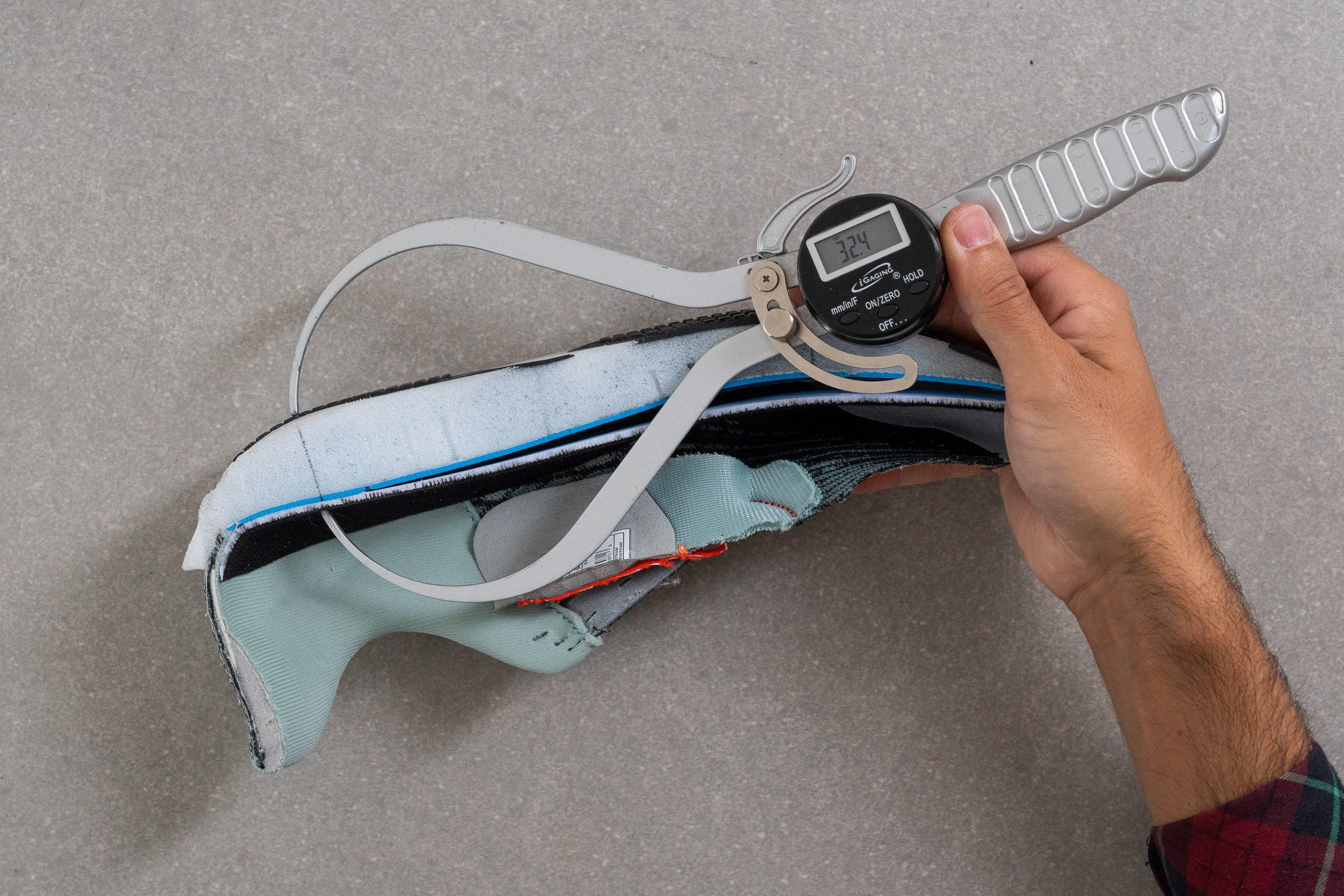
| Hyperion Max | 32.4 mm |
| Average | 34.8 mm |
Forefoot stack
The forefoot has a thickness of 24.2 mm. This should work well for most forefoot strikers and it doesn't mute the ground feel at all.
However, if you're on the heavier side and you strike with your forefoot, you might want to go for a shoe with more cushioning, like the ASICS Superblast.
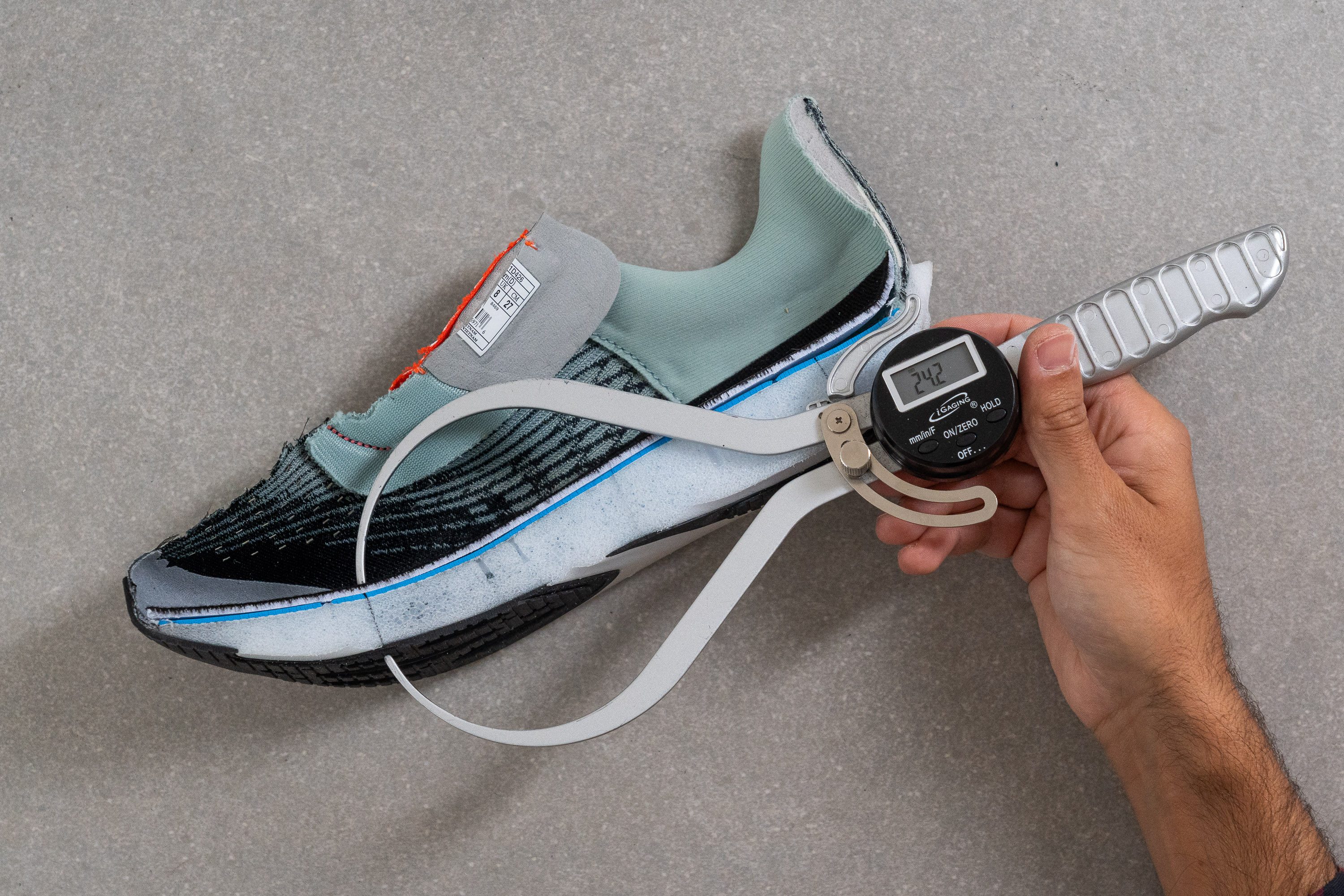
| Hyperion Max | 24.2 mm |
| Average | 26.2 mm |
Drop
We measured the heel-to-toe drop in the Hyperion Max and found it to be 8.8 mm. This is pretty close to the 8 mm drop that Brooks claims.
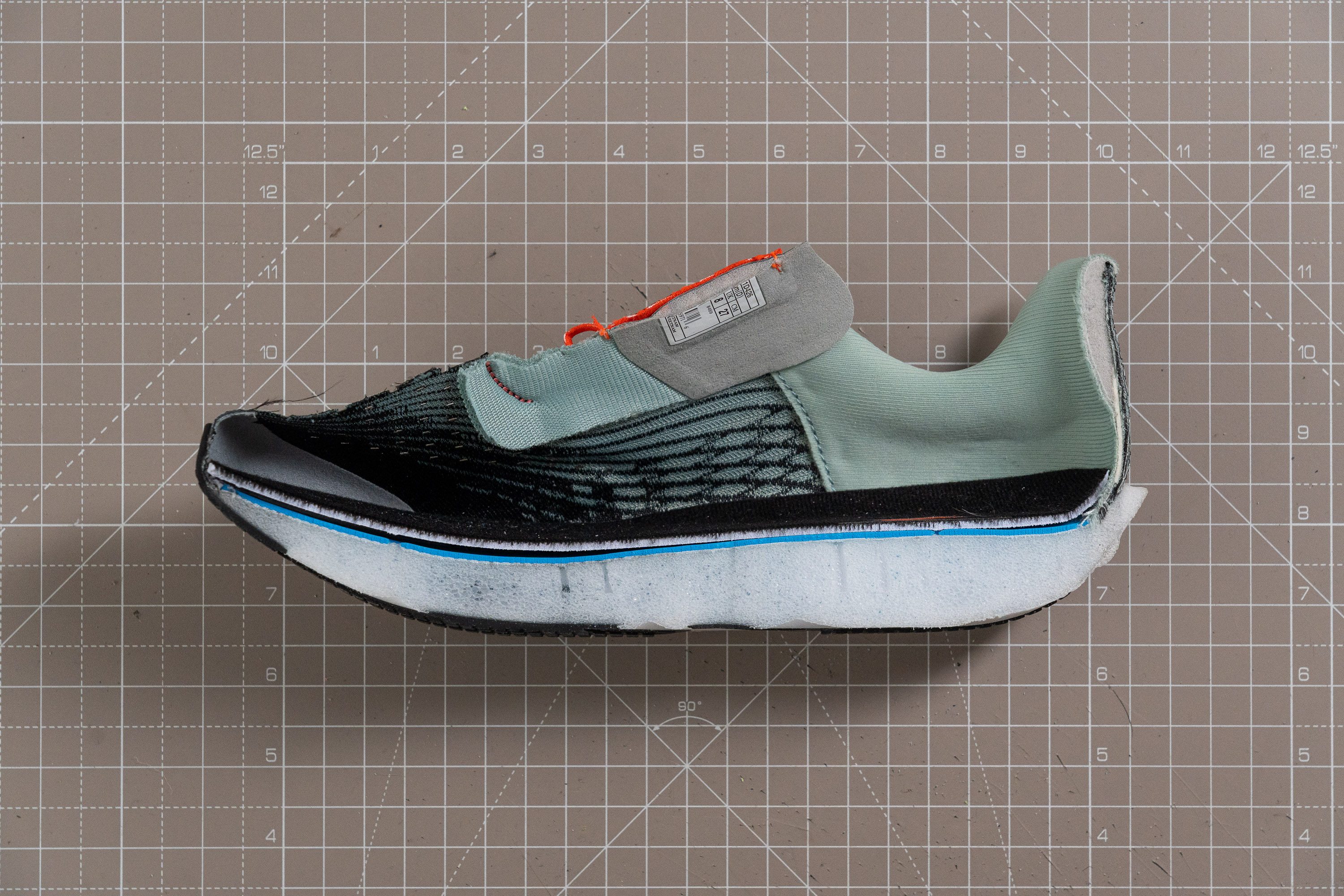
| Hyperion Max | 8.2 mm |
| Average | 8.6 mm |
Midsole softness
Before running any tests in the lab, we wanted to get a feel for the Hyperion Max by taking it for a first run.
This shoe uses DNA Flash foam, which gives a snappy feel underfoot. It's not super cushy, but that's not a bad thing for many runners that favour a more old-school feel.
After that initial run, we measured the foam's softness with a durometer. The result, at 20.8 HA, confirmed what we felt. The shoe offers a balanced feel—neither too soft nor too firm.
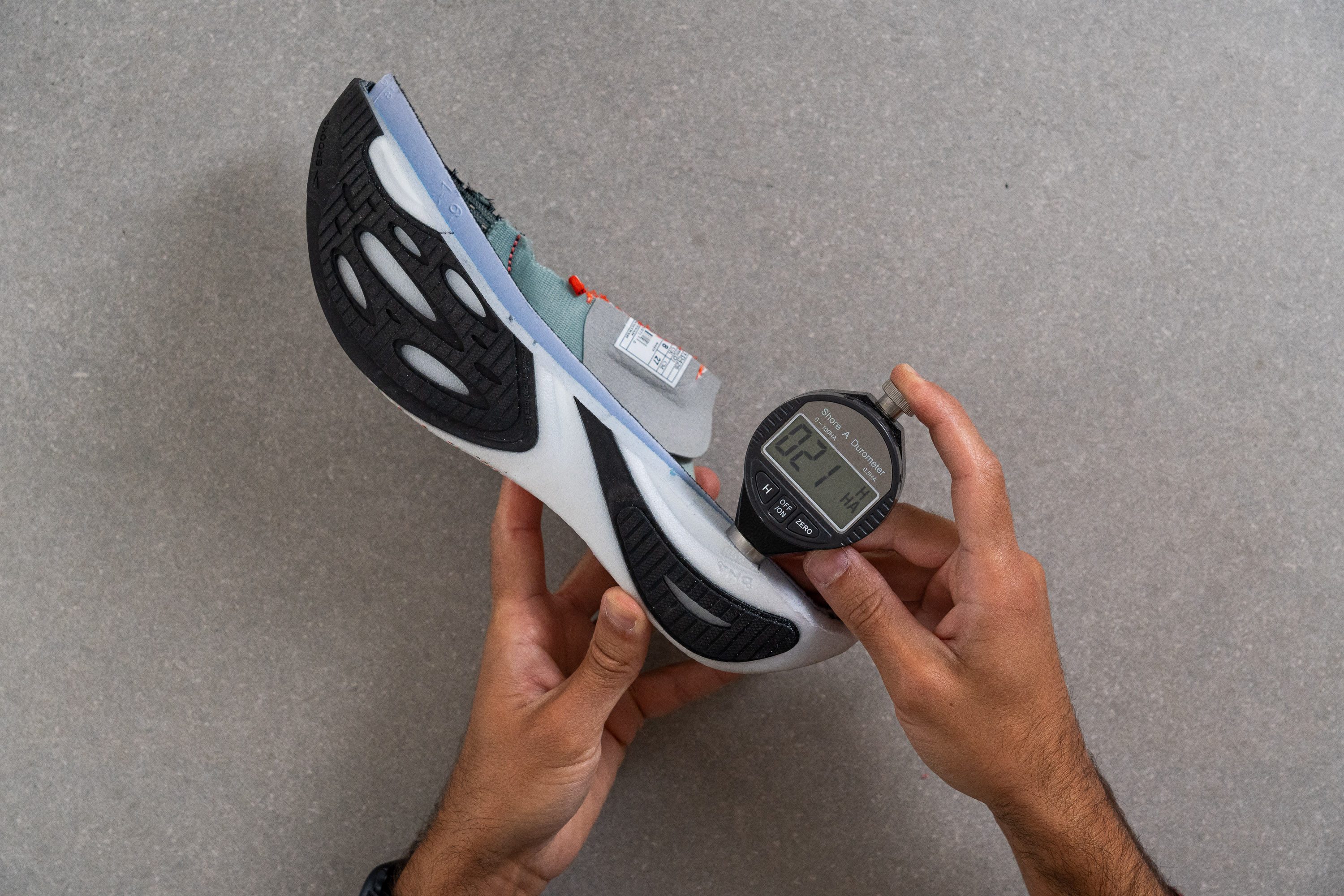
| Hyperion Max | 20.8 HA |
| Average | 20.4 HA |
Size and fit
Size
Brooks Hyperion Max fits true to size (292 votes).
Width / Fit
We clocked the toebox width at the widest part of the upper and found it to be only 96.1 mm.

If you have narrow feet, you'll likely enjoy this shoe. It's also a good choice for people with regular-width feet who like a snug, race-like fit. But if you have wide feet, you might consider going up a size, although that's not a surefire solution.
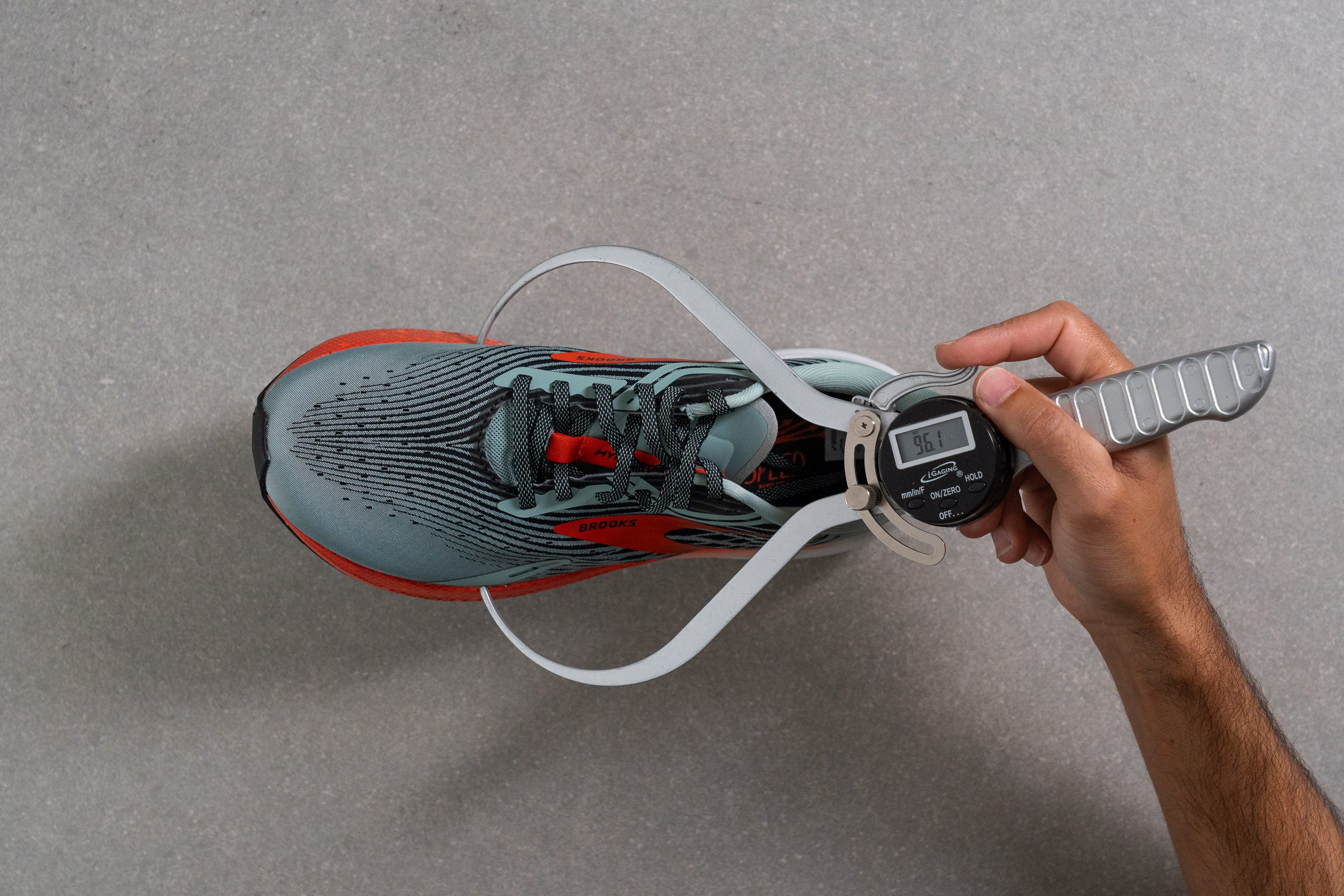
This test follows an older methodology, which is why you don't see recently tested shoes in the chart. Results from different methodologies can not be compared.
| Hyperion Max | 96.1 mm |
| Average | 98.5 mm |
Toebox width
Surprisingly, there's room for toe splay. We really appreciate Brooks' choice to design a rounded toebox (78.4 mm at the big toe area). It's a rare and fantastic feature that offers a natural and comfy fit for your feet.
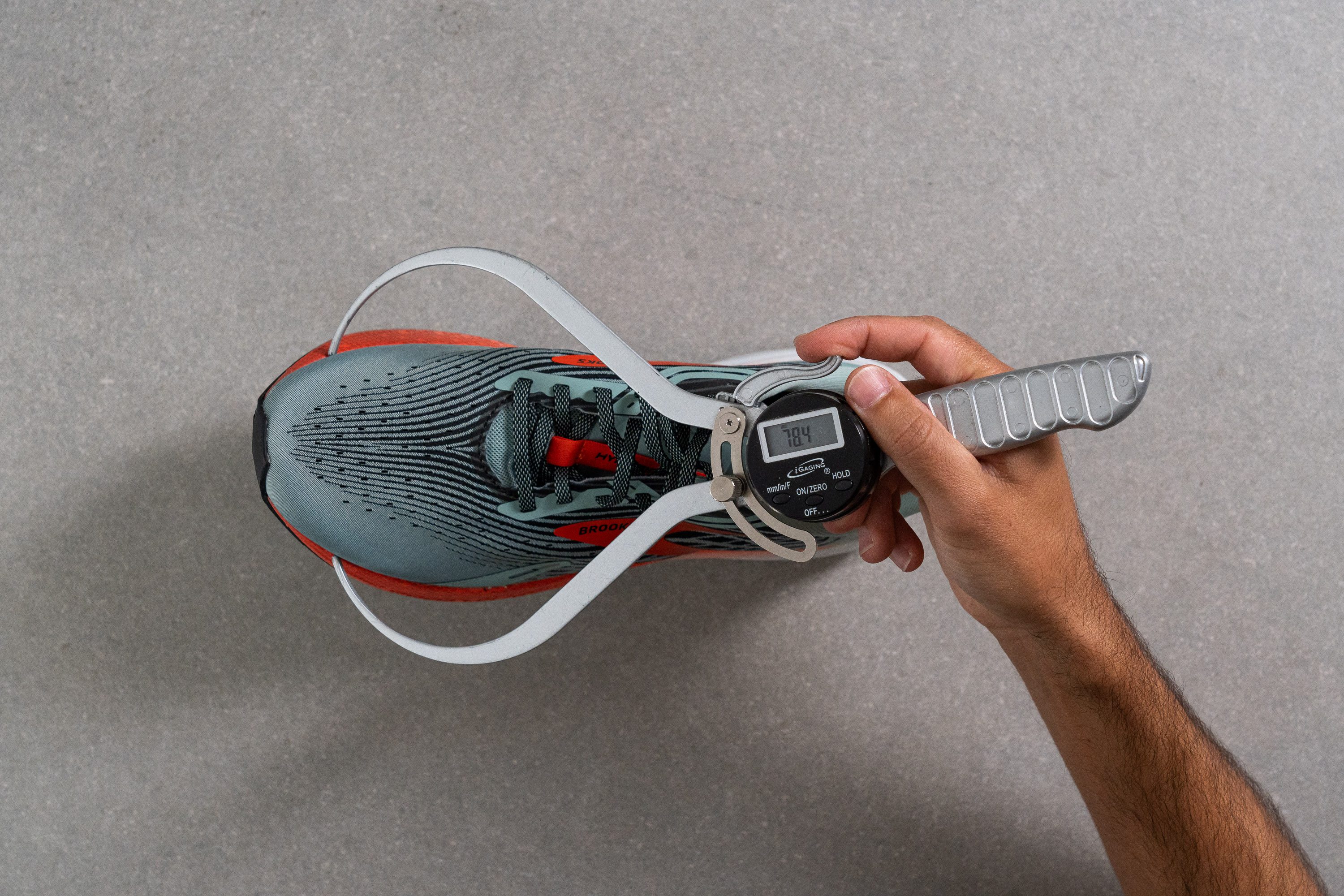
This test follows an older methodology, which is why you don't see recently tested shoes in the chart. Results from different methodologies can not be compared.
| Hyperion Max | 78.4 mm |
| Average | 78.4 mm |
Traction / Grip
Traction test
Unfortunately, the Hyperion Max doesn’t live up to its name when it comes to traction. We measured a modest 0.35 score—good enough for dry surfaces, but with some noticeable hesitation on slick or rain-soaked roads.
| Hyperion Max | 0.35 |
| Average | 0.48 |
Outsole design
The outsole of the Brooks Hyperion Max features partial rubber coverage concentrated in high-impact zones at the heel and forefoot. The rubber sections use a textured layout with horizontal slits to improve flexibility. The design also includes a central channel that runs from midfoot to toe-off, optimizing weight distribution.
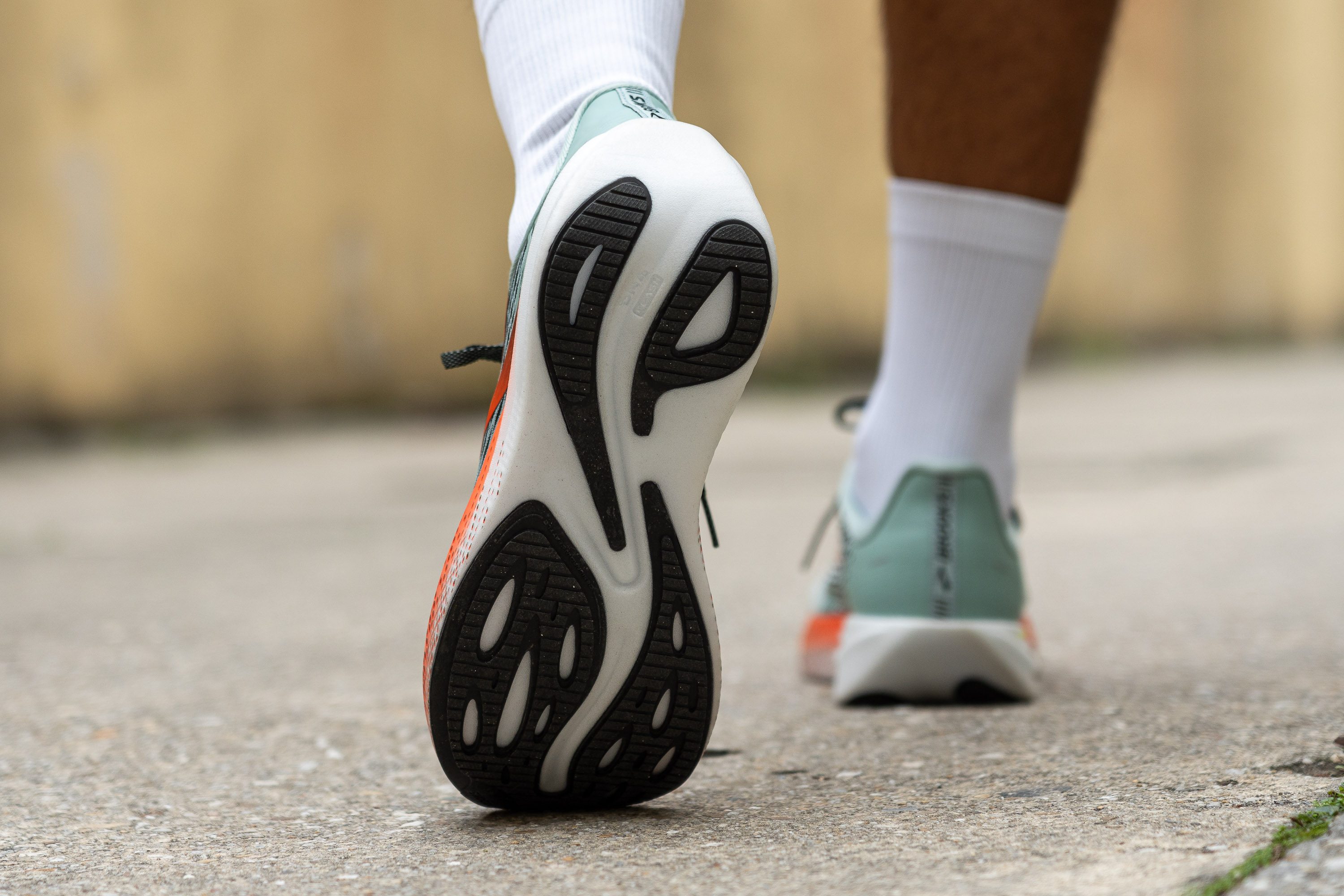
Flexibility / Stiffness
When we first twisted the shoe in our previous flexibility test, it felt really pliable. To get a better idea of just how flexible the Hyperion Max is, we pushed it to a 30-degree angle in the lab. We found that it only took 13.5N of force, which shows that Brooks aimed to make a flexible and comfy shoe.

| Hyperion Max | 13.5N |
| Average | 15.3N |
Stiffness in cold (%)
After putting the shoe in the freezer for 20 minutes, just like we did for the foam softness test, we measured the force again. This time, we found that it took 27.9N of force.
That's only an 8.3% increase in force, a truly remarkable result compared to most other shoes out there. Once again, we have to congratulate Brooks for this outstanding performance under cold temperatures.
| Hyperion Max | 8% |
| Average | 33% |
Weight
The major highlight of this shoe is its mind-blowing lightness.
Tipping the scales at a mere 7.5 oz (213g), it easily holds its own against racing shoes but offers far superior comfort.
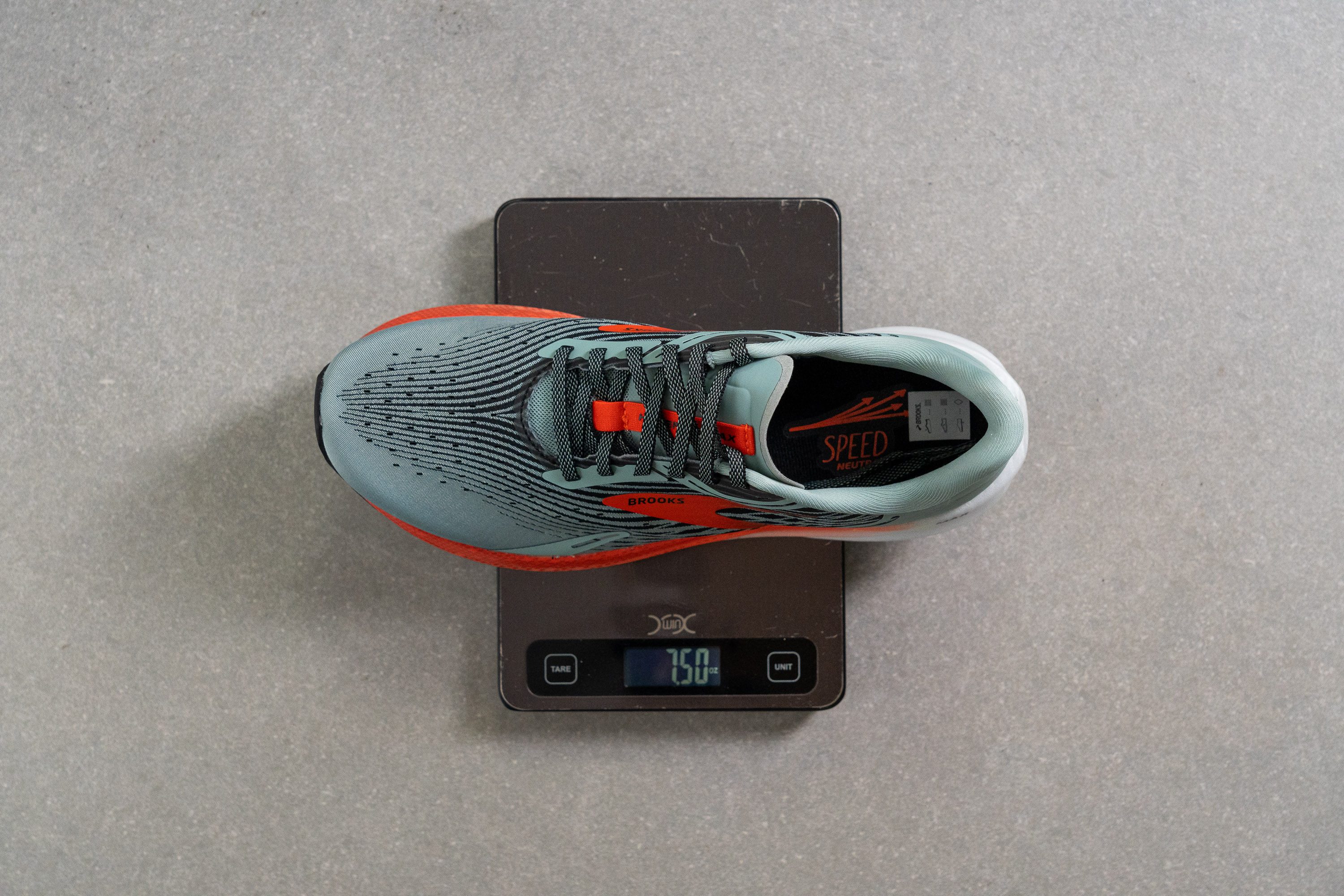
| Hyperion Max | 7.5 oz (213g) |
| Average | 9.3 oz (264g) |
Breathability
We're kicking off this lab review on a high note: the Brooks Hyperion Max really shines when it comes to breathability.
In our lab, we typically run a series of tests in this regard, but the first one was enough to show us that this shoe is a top pick for summer training. Just look at how well it ventilates!
We've covered various ways to make a shoe breathable in our detailed guide on the topic. Of all the options, Brooks chose to use ventilation holes, and it's a choice that paid off. This shoe scored a perfect 5 out of 5 in our breathability test.
During our light test, we observed numerous ventilation holes extending from the toe box to the midfoot area. To get a close-up view of these holes, we used a microscope. And what we found was fascinating.
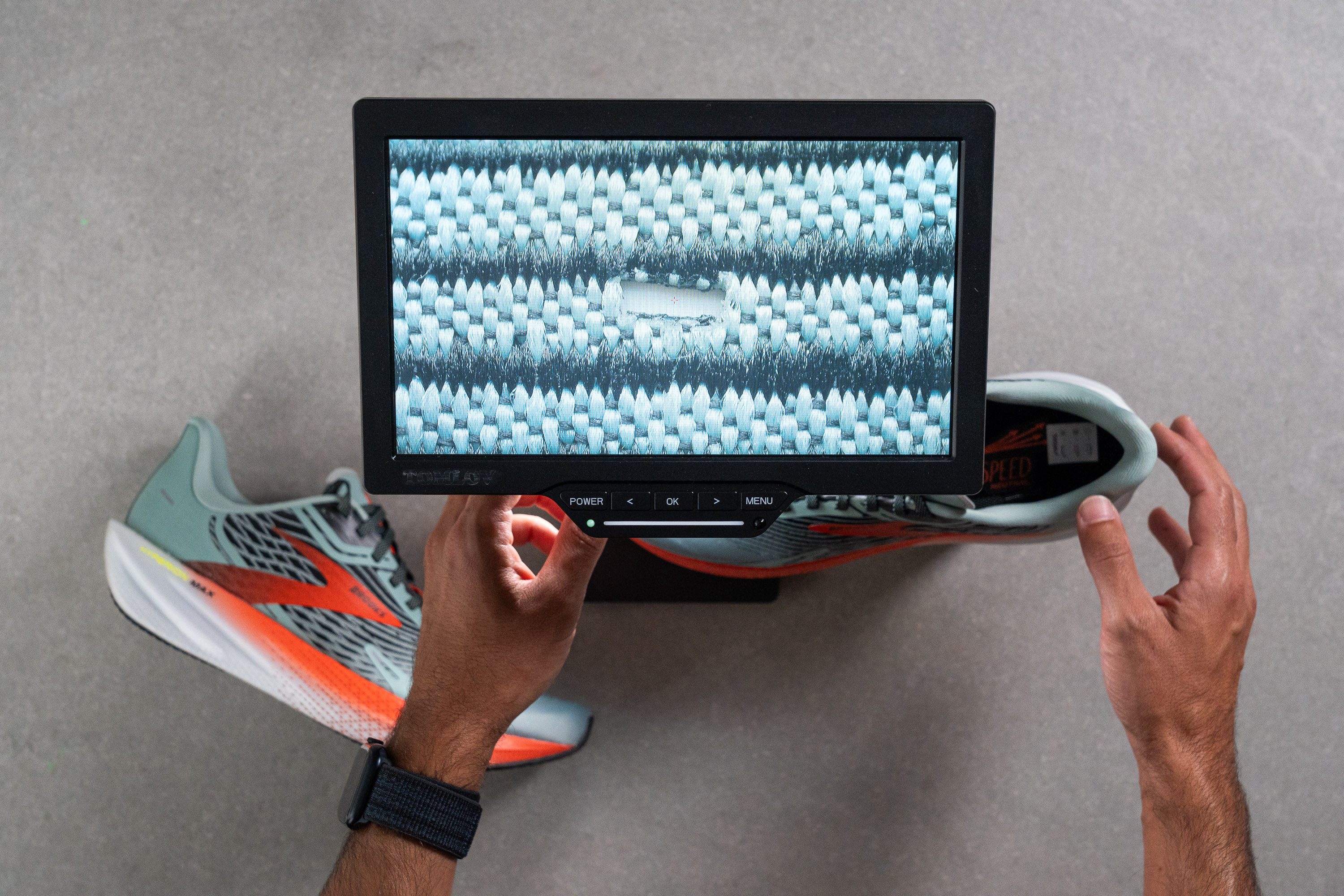
Brooks uses a thick engineered mesh in the shoe's design. Without these large holes, the mesh would not have provided adequate breathability. However, the size of these holes ensures the shoe stays well-ventilated.
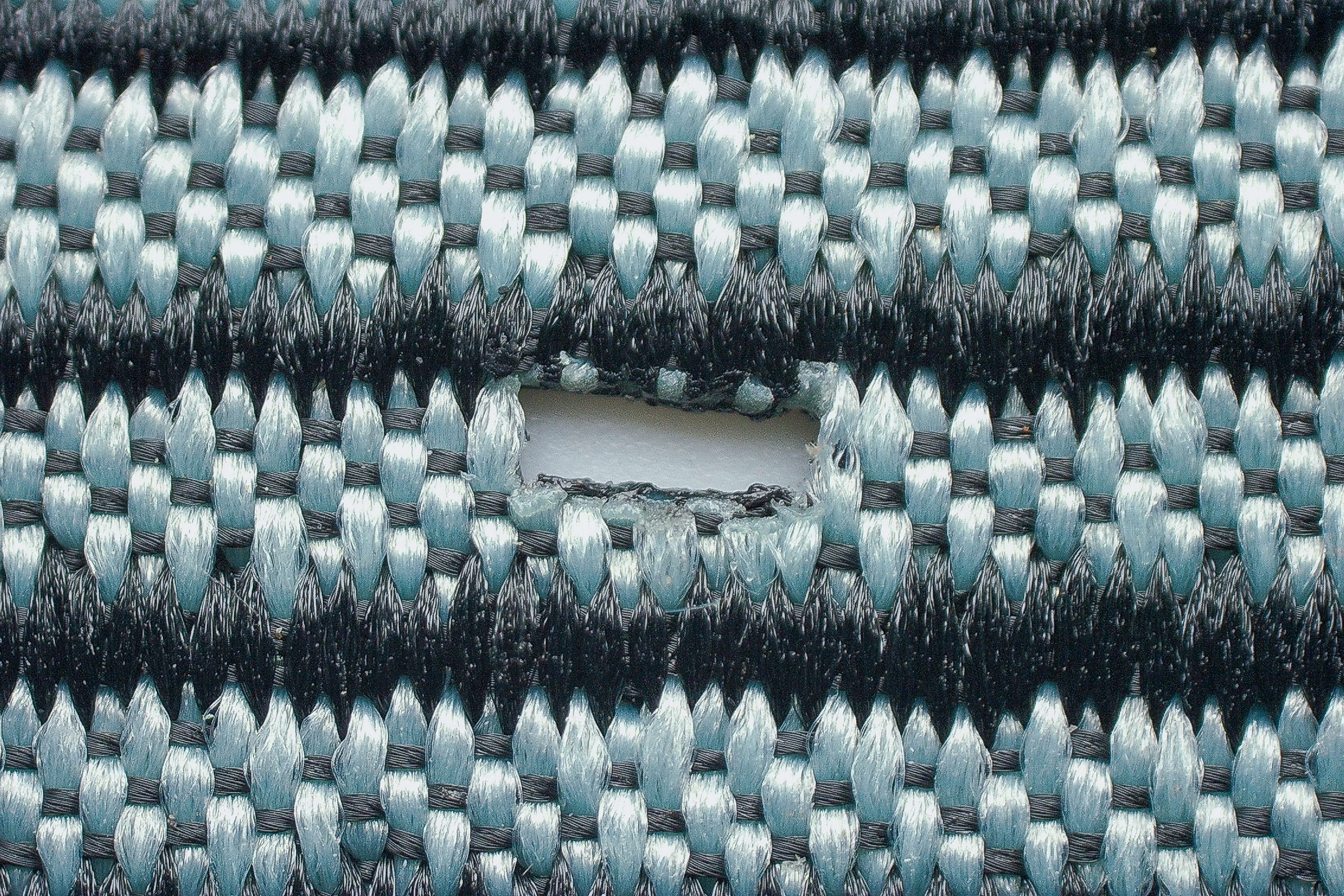
Lastly, we discovered that this shoe prioritises breathability over comfort. We love examining uppers, and we noticed that, unlike most other shoes, the inside of this shoe's upper lacks any fabric.
| Hyperion Max | 5 |
| Average | 3.7 |
Stability
Lateral stability test
We found that the Hyperion Max is a 100% neutral shoe. It doesn't have any extra features to help with stability—no side walls either. So if you're a pronator, this might not be the best fit for you. It's really best-suited only for neutral runners.
Torsional rigidity
Another thing that caught our attention is the shoe's flexibility. We measured it and gave it a score of 2 out of 5 in our twist test.
This low score means the shoe offers lots of agility and a smooth ride. But just like we mentioned earlier, this flexibility also means the shoe isn't that stable for non-neutral runners.
| Hyperion Max | 2 |
| Average | 3.5 |
Heel counter stiffness
We found that the heel counter has a moderate level of firmness, which we rated as 3 out of 5. This should suit most runners just fine.
However, if you have a particularly sensitive Achilles tendon, you might find it a bit on the stiff side.
| Hyperion Max | 3 |
| Average | 2.9 |
Midsole width - forefoot
The shoe weighs just 7.5 oz, so we thought it would have a narrow platform. However, when we measured it in the lab, the forefoot was 110.0 mm wide. That's actually pretty close to the average width.
We also found that the shoe felt safe and secure when we landed on the forefoot at any pace.

| Hyperion Max | 110.0 mm |
| Average | 114.4 mm |
Midsole width - heel
The heel design is pretty similar to the forefoot. We measured this one at at 88.1 mm in the lab, which is close to average.

| Hyperion Max | 88.1 mm |
| Average | 90.7 mm |
Durability
Toebox durability
Breathable shoes often come up short in the durability department, so we were eager to see how the Hyperion Max would hold up.
To our delight, the shoe earned a 2/5 score in our dremel test. It's an impressive achievement for a model that's both incredibly light and well-ventilated.
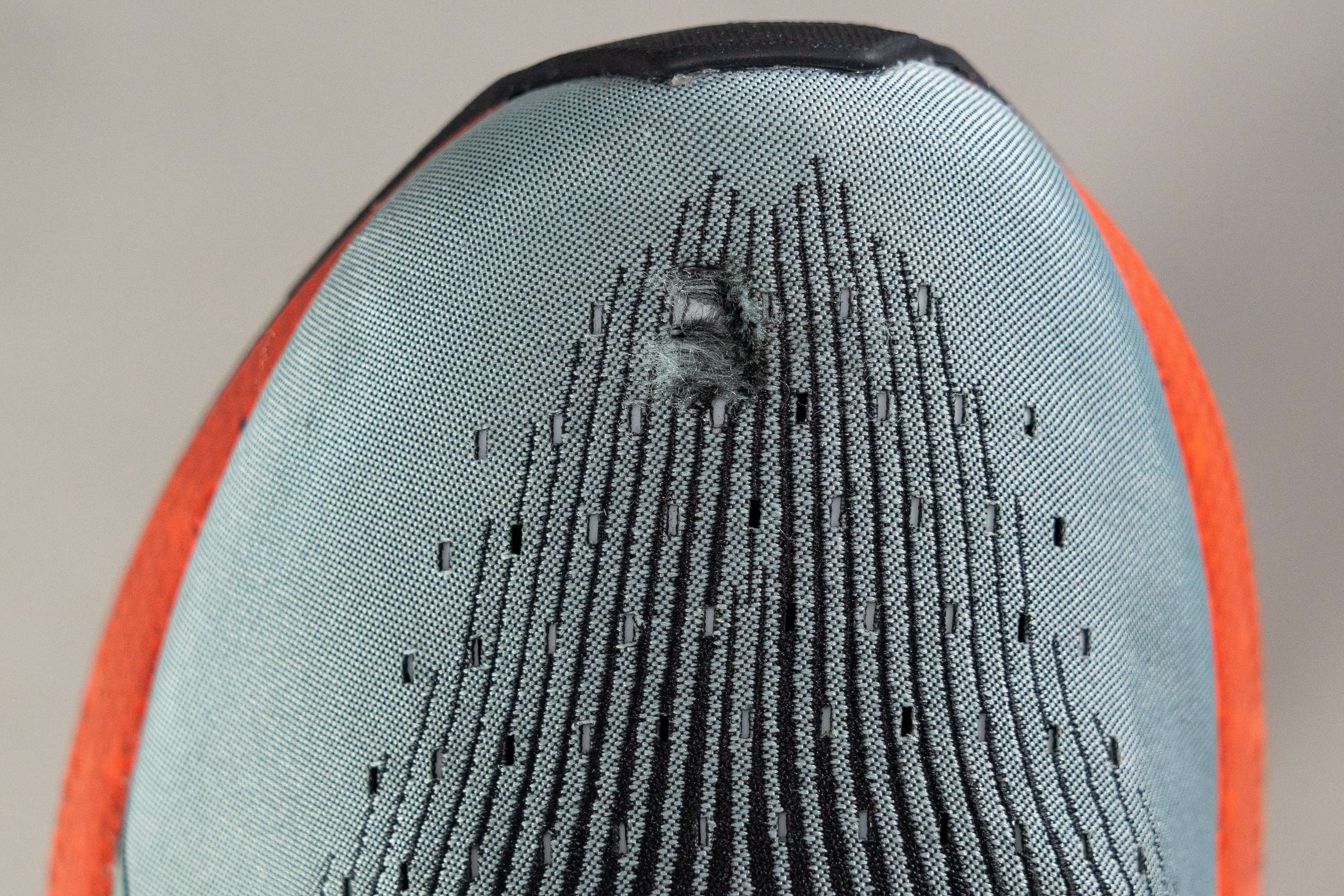
| Hyperion Max | 2 |
| Average | 2.6 |
Heel padding durability
We found that the heel area also scored a 2/5, which was a bit underwhelming. We expected a bit more durability in this area from the Hyperion Max.
Still, since it didn't score a low 1/5, it shouldn't be a concern for almost all runners.
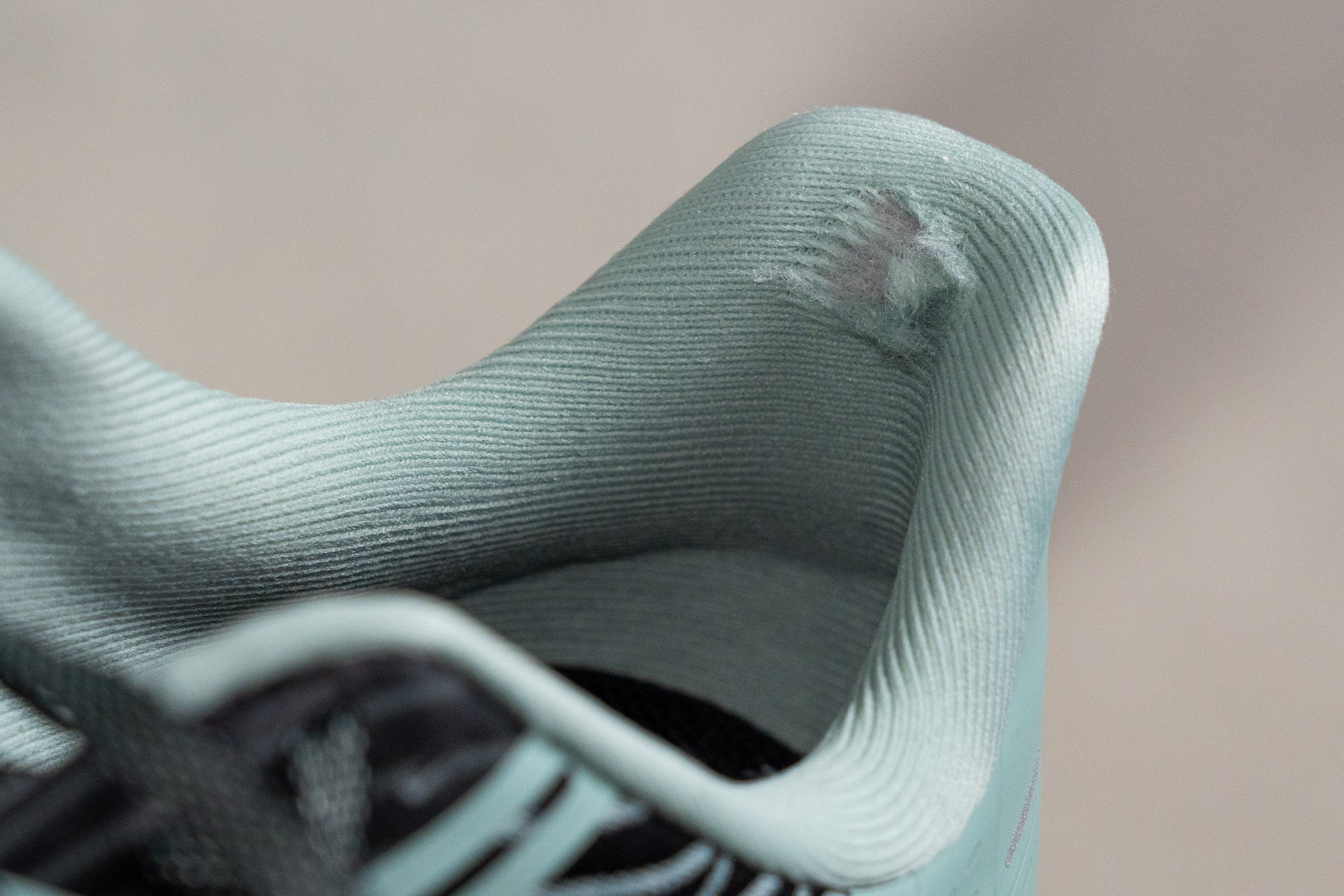
| Hyperion Max | 2 |
| Average | 3.4 |
Outsole hardness
Next, we focused on the outsole to check its durability. Our first test measured the hardness of the material. In the lab, we determined that it was a bit below average at 78.6 HC.
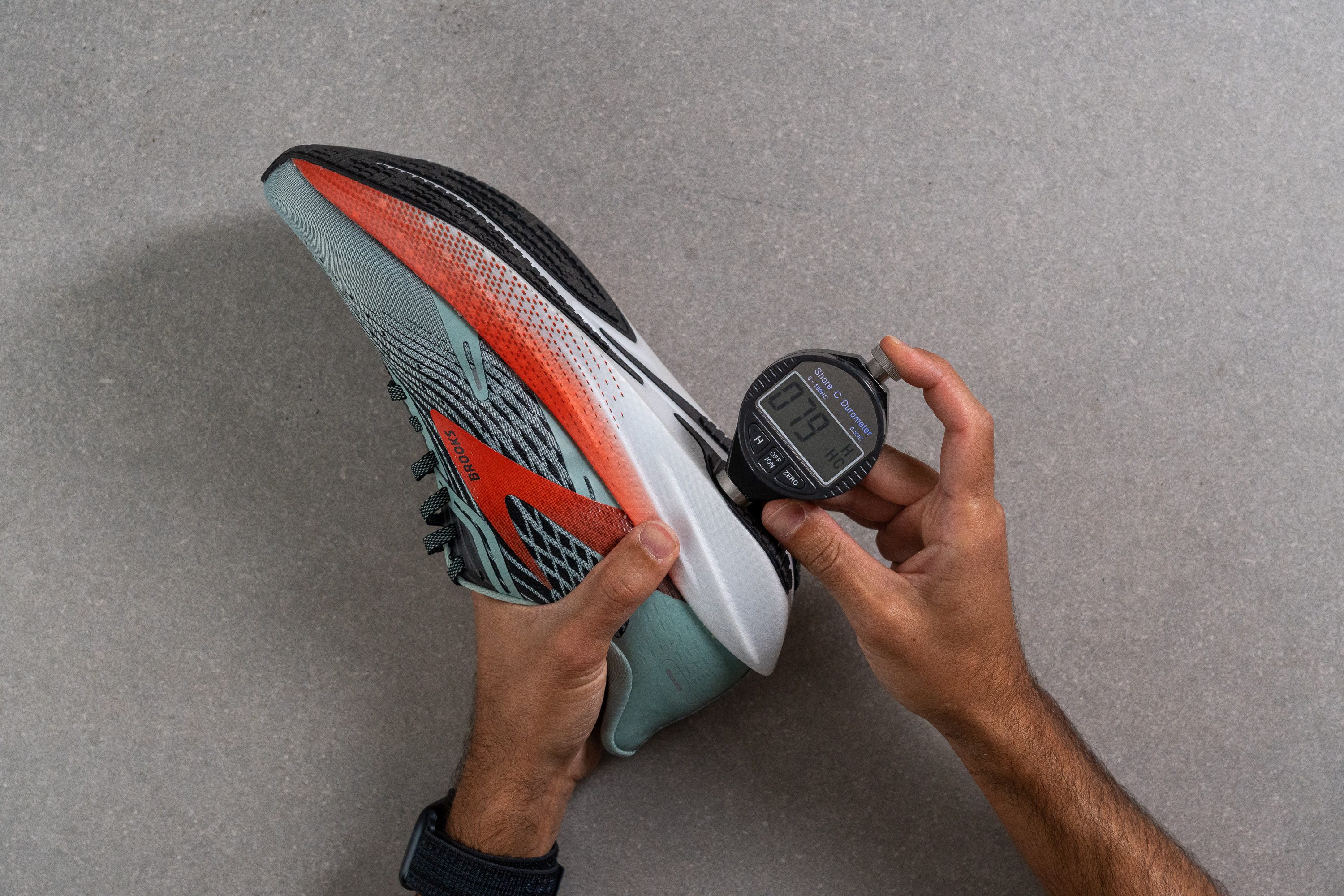
| Hyperion Max | 78.6 HC |
| Average | 79.2 HC |
Outsole durability
For the ultimate test of the outsole's durability, we rev up the Dremel one final time.
We measured a 0.7 mm indentation in the outsole—truly a good result that points to long-lasting wear.
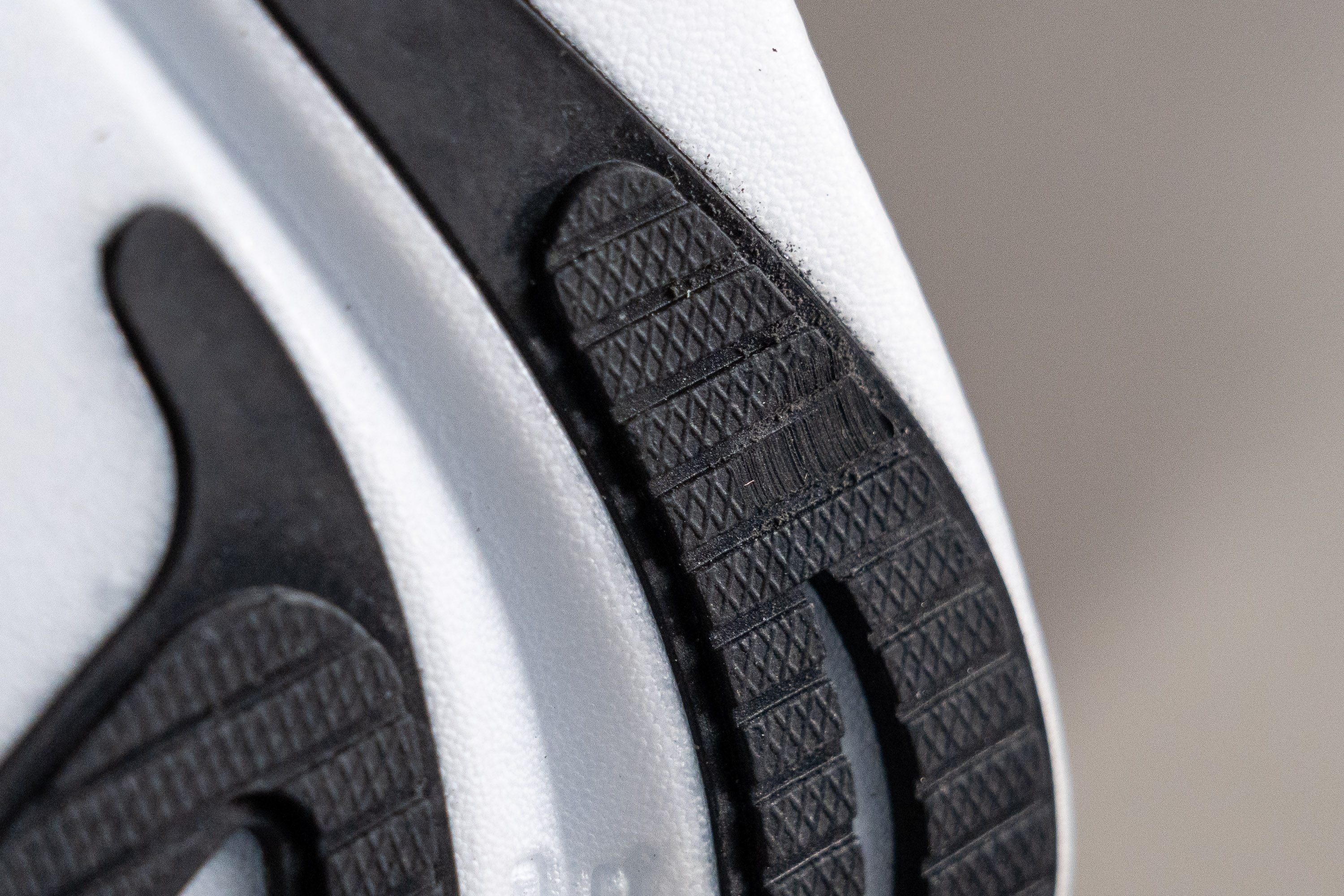
| Hyperion Max | 0.7 mm |
| Average | 1.1 mm |
Outsole thickness
We measured the thickness of the outsole and found it to be 3.0 mm, clearly aimed at keeping the shoe lightweight. This seems like enough, but it's important to note that there's a lot of exposed foam on the shoe.
We observed that the rubber is smartly placed to cover the areas that take the most beating while running, so it should hold up well over time.
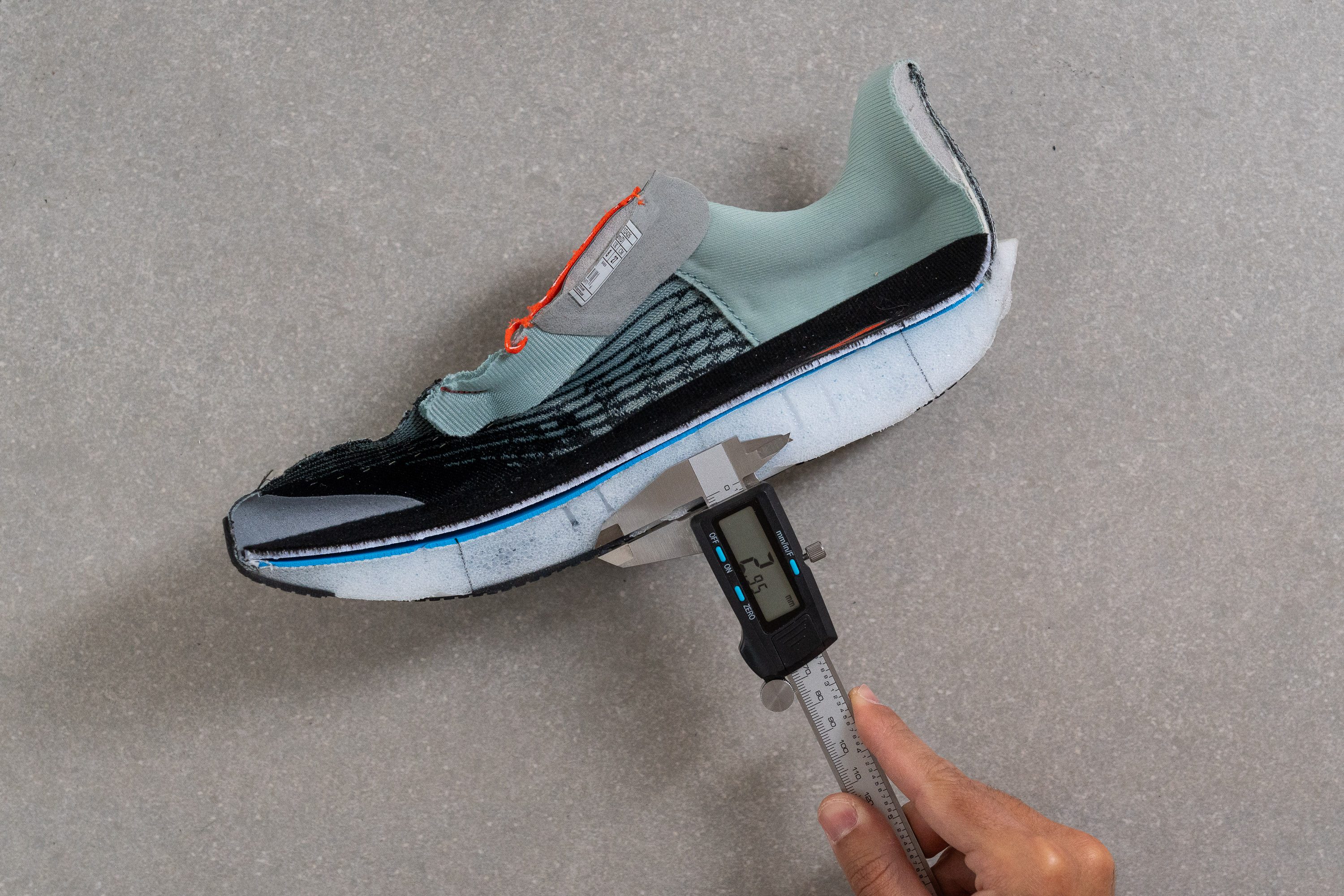
| Hyperion Max | 3.0 mm |
| Average | 3.2 mm |
Misc
Insole thickness
When we cut in half the Hyperion Max, one of the first things we observed was its incredibly thin insole. A 2.6-mm insole is really unusual, but we think it's great for this particular shoe. Weight savings!

| Hyperion Max | 2.6 mm |
| Average | 4.5 mm |
Removable insole
The Hyperion Max comes with a removable insole. However, as we said before, the shoe has a unique shape—it's snug in the forefoot but has a rounded toebox.
Because of this, most third-party insoles don't really fit well. However, if you're looking for that perfect fit, we discovered that custom-made orthotics can be a solid option.
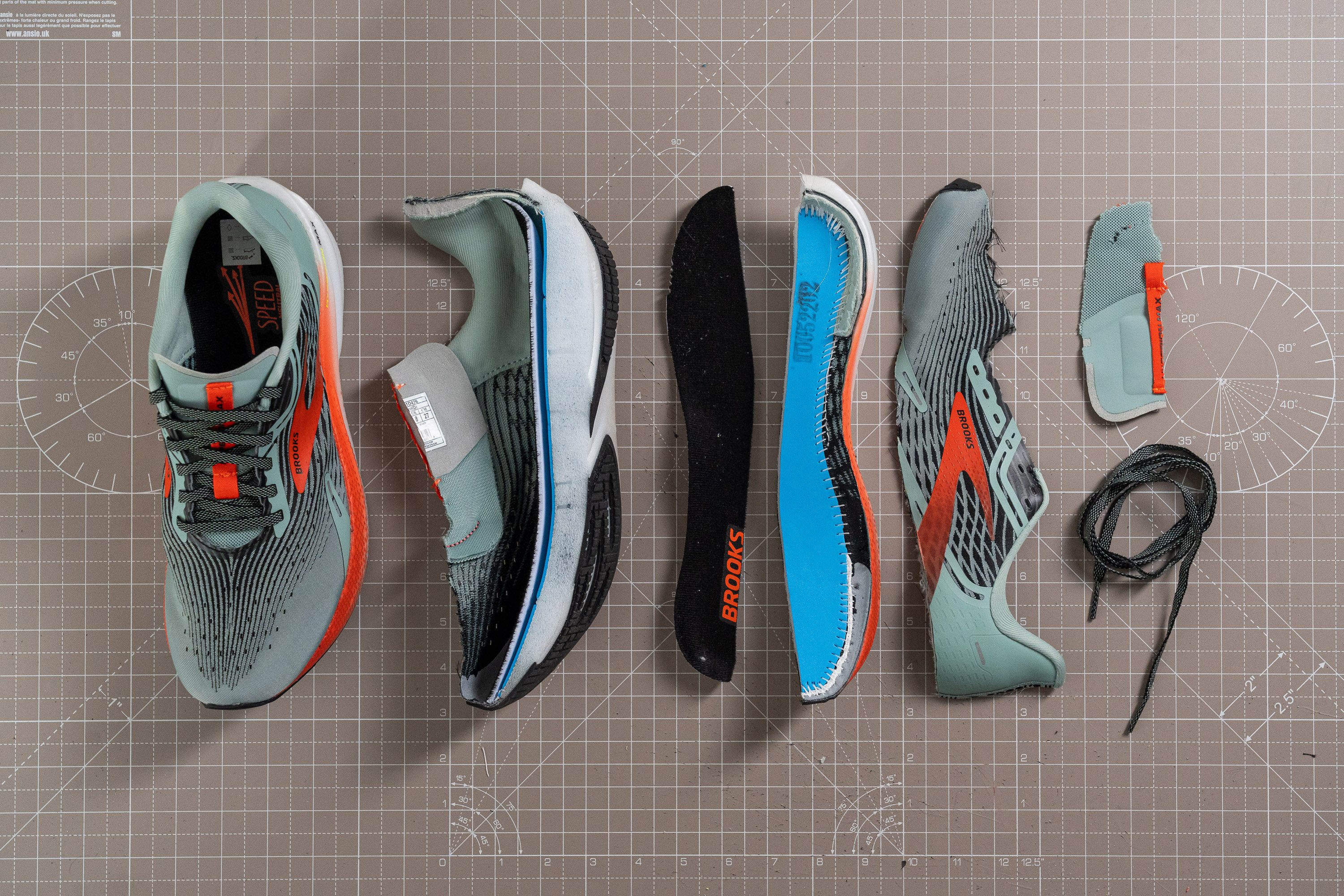
| Hyperion Max | Yes |
Midsole softness in cold (%)
We put the shoe in the freezer for a quick 20-minute nap and then measured its softness again. We found that the reading was 22.5 HA, which is pretty much the same as what we got at room temperature.
We observed just an 8.4% increase from the first test, and let that's one of the best results we've ever seen in the lab. Many other running shoes in the same price range can't even come close in this test.

| Hyperion Max | 8% |
| Average | 24% |
Reflective elements
Sure, the shoe has some reflective elements, but the tiny strips Brooks added are barely noticeable. It's disappointing, especially if you're counting on them for visibility.
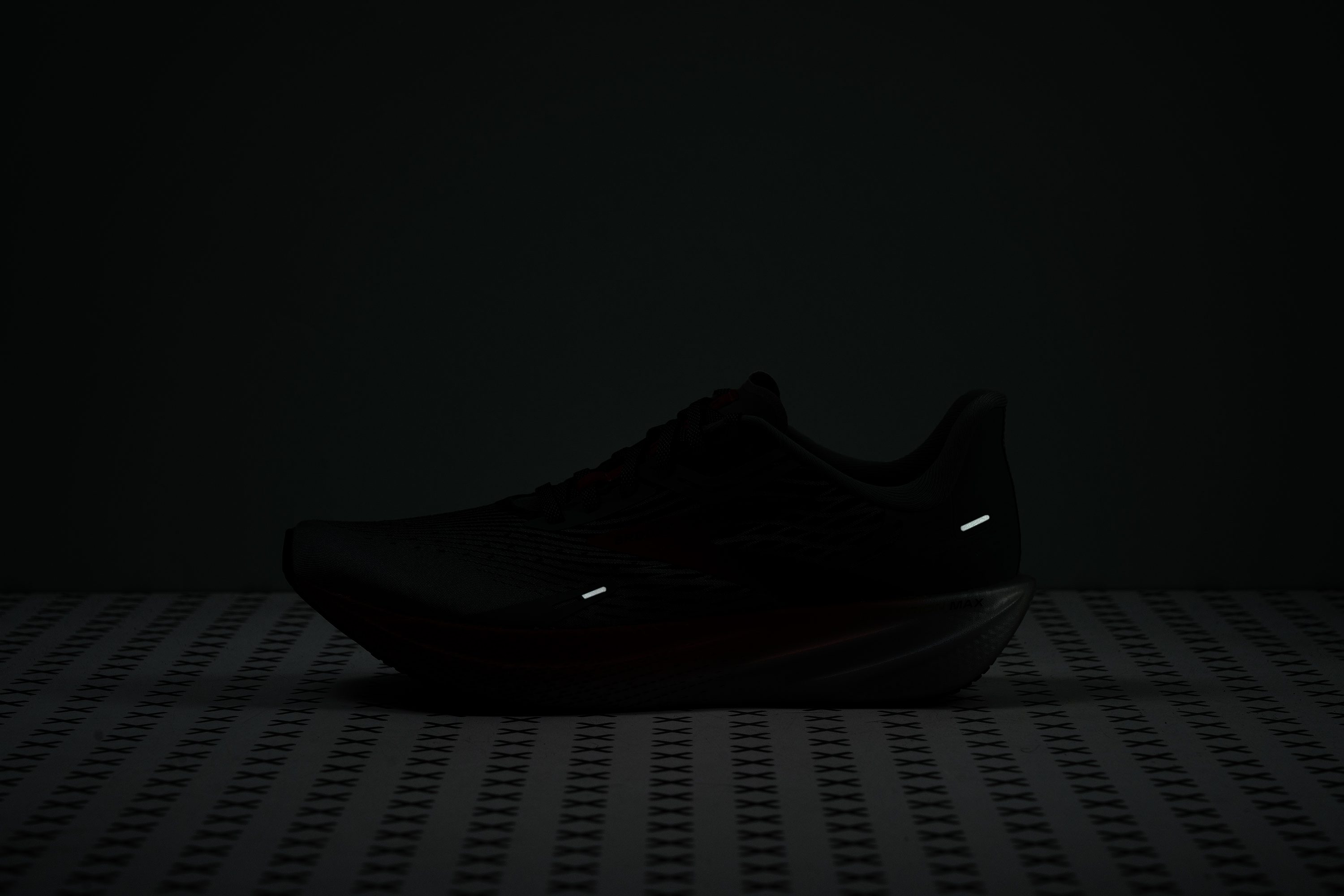
| Hyperion Max | Yes |
Tongue padding
Brooks probably left out the gusseted tongue to make the shoe lighter. But they could have used a thinner tongue and added a gusset with the saved weight.
That said, we found that the 5.4-mm tongue is actually quite comfortable for long runs!
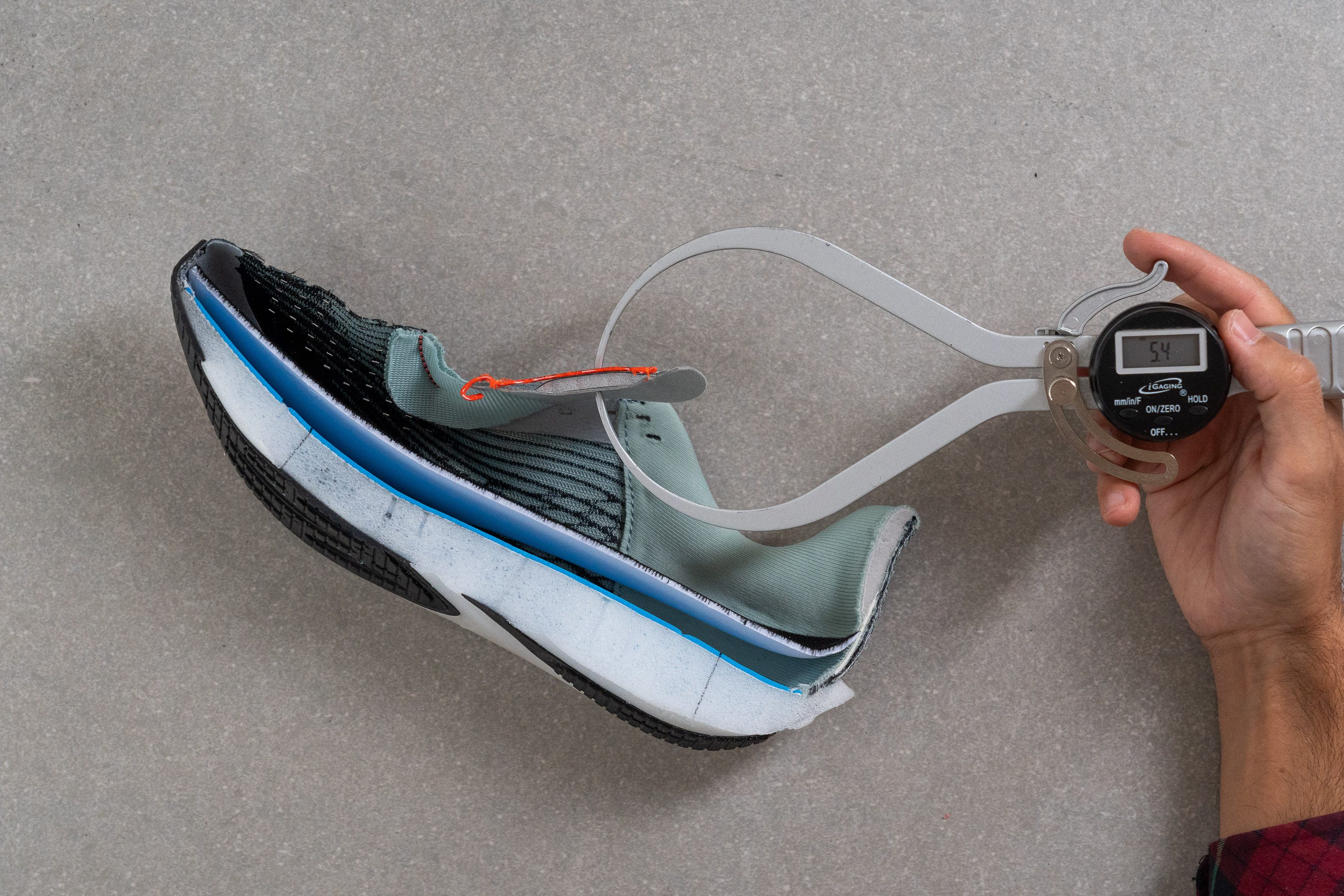
| Hyperion Max | 5.4 mm |
| Average | 5.8 mm |
Tongue: gusset type
Sadly, in the quest to make the shoe lighter, Brooks left out a gusset in the tongue. For a £170 shoe designed for fast runs, we find this to be disappointing.
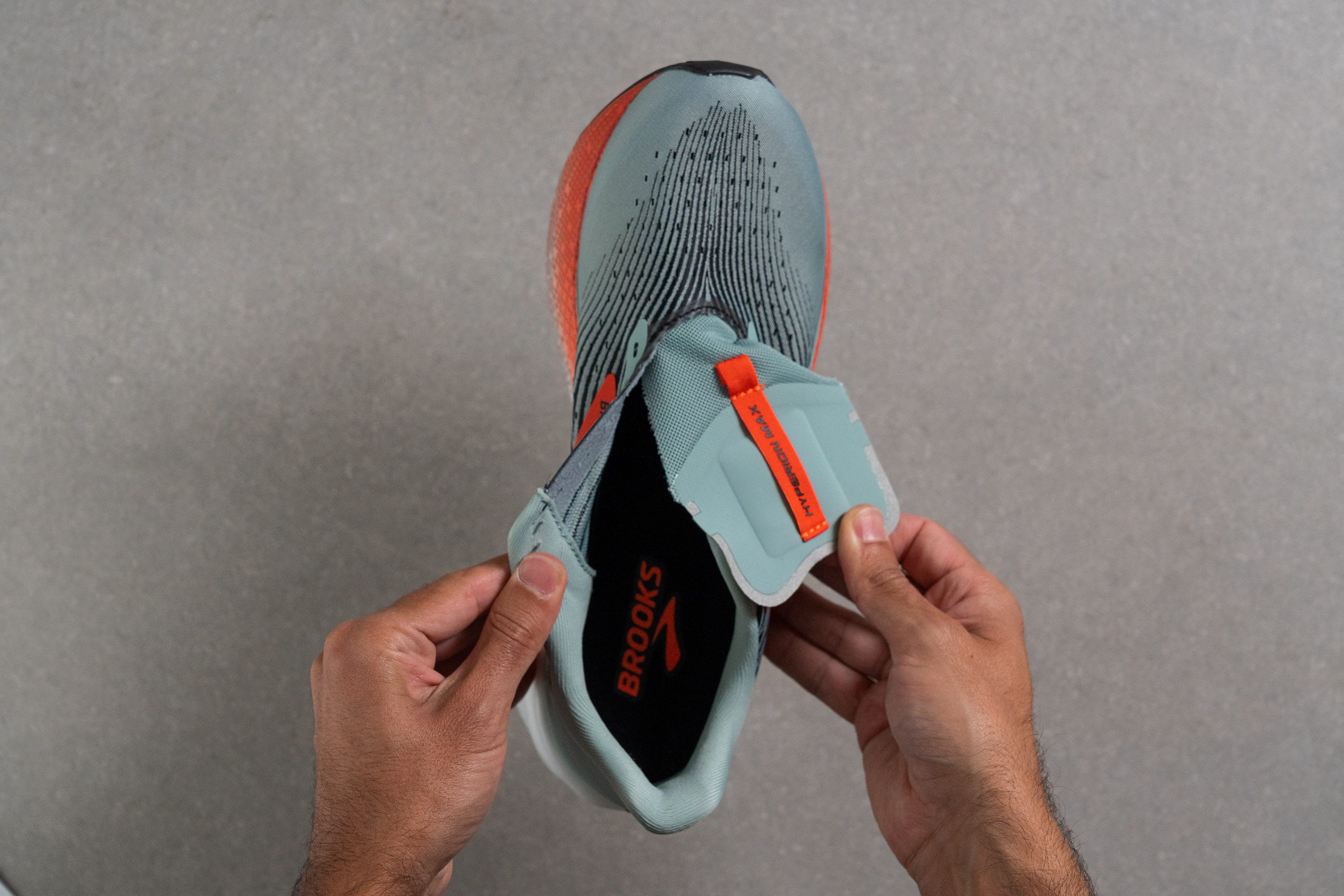
| Hyperion Max | None |
Heel tab
Brooks skipped the heel tab, but honestly, we didn't even miss it when putting on the shoes.
It's more about the look than function. And they did throw in a branded strip in the heel, so you'll always remember who's got your feet covered!
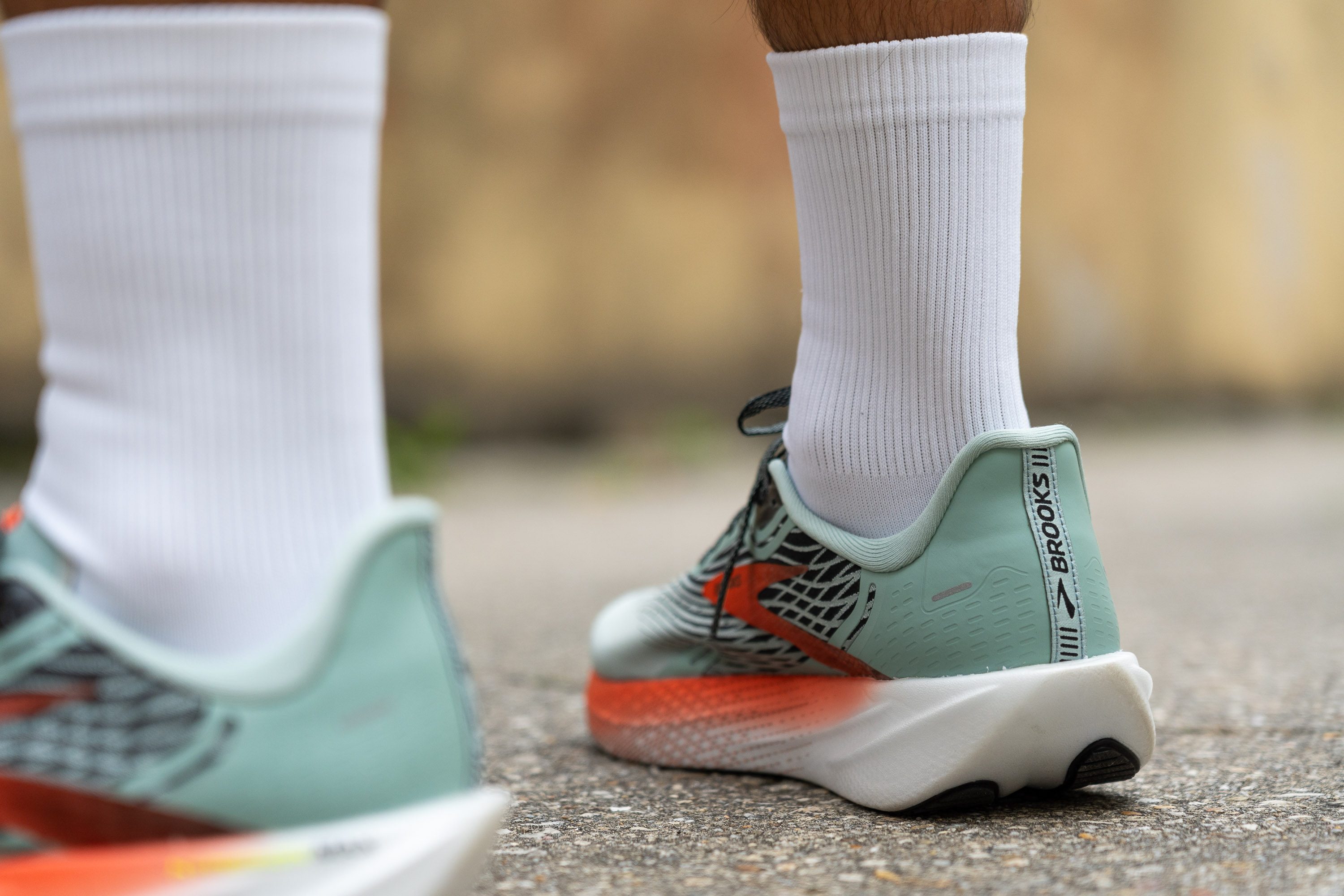
| Hyperion Max | None |

